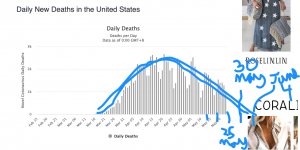Start with a common sense number…based on the whole idea of “social distancing”…that is the number which I have not heard on the news…
numbers of people per square mile living in an area
Then let’s relate that number to death. Here’s how it could help with policy and how linear regression may make some predictions…
A. First calculate numbers of people per square mile living in a state…
New York State–352 people per square mile (19 million people; 54 thousand square miles).
New York State–352 people per square mile (19 million people; 54 thousand square miles).
Alabama- 94 people per square mile (4.9 million people; 52,000 square miles).
B. Now, look at deaths per million people living there (NOT total numbers of deaths)…
New York…. 1,496 deaths per million people (so far, as of 2020May24)
Alabama….. 112 deaths per million people (so far, as of 2020May24)
Lots of people in less area can be very good. For example, my middle son wanted to take fencing lessons in high school; but, there are not enough people in our area to support a club or even a teacher.
So, lots of people can be a good thing.
But, over 60% of people who got Coronavirus in New York were sheltering at home. If your home is in the middle of a field or even in suburbs with walking space between houses–maybe staying at home does something different compared with if you are staying at home in one structure that shares hallways and elevators, etc. with thousands of other people.
Again, not good or bad…but definitely NOT the same.
C. Then assume numbers of people per square mile is an independent variable and do a linear regression on the data (actual deaths per million and numbers of people per square mile) to find the formula for the line…
The following formula represents the linear regression on a sampling of the data from each state…
y = 71 + (0.77x)
y =predicted number of deaths per million
x = (number of people in the state/number of square miles in the state)
Here’s the regression analysis that shows a linear relationship (click to review the math). This would need to be recalculated with time as the number of deaths changes. The calculation is current as of 2020May26 (click)<–States Regression Analysis
You can use google and this chart (click) to check the calculation of that formula for predicting death rates based on population density.
D. Now, let’s see which states are doing better or worse than predicted…
For example…
Wyoming:
6 people per square mile (578,000 people in 97,000 square miles)
(0.77 x 6) + 71 = 75 deaths per million predicted based on population density
Wyoming:
6 people per square mile (578,000 people in 97,000 square miles)
(0.77 x 6) + 71 = 75 deaths per million predicted based on population density
Wyoming actual deaths per million = 21 (better than predicted)
New York State:
413 people per square mile (19,440,469 people in 47,126 square miles)
(0.77 x 413) + 71 = 318 predicted deaths per million based on population density
413 people per square mile (19,440,469 people in 47,126 square miles)
(0.77 x 413) + 71 = 318 predicted deaths per million based on population density
New York State actual deaths per million = 1,507 (worse than predicted)
Alabama
94 people per square mile (4,900,000 people in 52,000 square miles)
(0.77 x 94) + 71 = 143 predicted deaths per million based on population density
94 people per square mile (4,900,000 people in 52,000 square miles)
(0.77 x 94) + 71 = 143 predicted deaths per million based on population density
Actual deaths per million = 112 (better than predicted by population density)
It makes common sense that people living closer together would have a higher death rate than those living more separated. So, then based on that assumption, linear regression was done that showed that indeed as population density goes up, so does death rate per million.
One way to measure how a state is doing might be…
what’s the death rate per million in relation to population density. If worse than predicted (New York) or better than predicted (Wyoming & Alabama), then maybe the policies of each state should be reconsidered and adjusted based partly on that number.
what’s the death rate per million in relation to population density. If worse than predicted (New York) or better than predicted (Wyoming & Alabama), then maybe the policies of each state should be reconsidered and adjusted based partly on that number.
I have no crystal ball. Just offering this formula as a way to judge the performance of a state.
FYI…
Why some are choosing June dates to open…
The following picture shows why Universal Studios opens June 5th and the Venetian Casino in Las Vegas also opens in June. The beaches in Gulf Shores are booked solid (it’s like the 4th of July here where I live). Remember, the number of cases will go up even if the incidence is going down if the number of tests goes up significantly. The most reliable number is the number of deaths per day since that does not change with increased numbers of testing the living.
3 Questions:
1) What if population density (numbers of people per square mile) matters in the spread of coronavirus?
2) What if it matters even more than what any of the politicians are saying or any of our policies?
3) If population density does matter, then can the death rate predicted by population density be used as a way to judge which policies are working best in each state and city?
Help us help the sick…
I hope this is helpful.
Peace & health,


Very interesting to read this article.I would like to thank you for the efforts you had made for writing this awesome article. This article inspired me to read more. keep it up.
Correlation vs Covariance
Simple linear regression
data science interview questions
Thank you very much for the useful links and kind words!